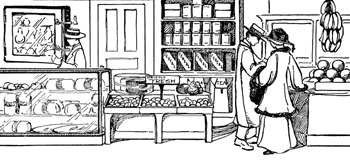Grocery Shopping Revisited
 |
| http://etc.usf.edu/clipart |
FACT: Food prices have been outpacing inflation for the past several years.
According to Bloomberg, the increase in the food-at-home portion of the Consumer Price Index rose 6% from August 2010 to August 2011. Beef and egg prices increased 14.5% and 14.9% respectively during the same time. During 2012, food inflation is predicted to slow a bit, but still be above the historical average for the last twenty years.
FACT: My children’s appetites have been outpacing food inflation rates.
Crazy as it sounds, with just six children at home, I’m preparing more food than when we had all nine under our roof. There’s a simple explanation, though: four teen. (Plus two very energetic, hungry younger boys.)
FACT: Our grocery budget has not increased during the past few years.
Actually it has tightened as we started taking our target number seriously. Using the Pear Budget system to track expenses has been a huge help.
UPSHOT: All this means that we’re watching our grocery pennies extra carefully and employing every reasonable trick to cut costs while still providing ample nutritious sustenance for the locusts.
A few preliminary words: Grocery shopping, meal planning, and meal preparation are a jigsaw puzzle with every family coming up with a unique picture. Key components that have to be weighed out are budget restraints, time realities, nutritional considerations, and taste. What you do at one point in your life may be very different from what you are able or need to do at another time. Please don’t leave this post feeling a weight of added things that you ought to do, but if anything is useful, take only that away!
That said, here are the shopping strategies I’m working with most frequently these days:
1. Take advantage of weekly sales by using online flyers.
If I could apply only one strategy, this would be it. Shopping sales and stockpiling pays off big-time!
Each week I sit down at the computer to make our shopping lists. Aldi and Kroger are our primary supermarkets, and both have online weekly flyers. In fact, though I do buy some things at Wal-Mart, because they do not offer weekly sale flyers for food, I don't do the bulk of my shopping there. Stocking up on sale items pays off richly.
A freezer and pantry area help provide space for many of the goodies you buy in advance. For produce items, if something is a great deal, I'll still buy in quantity and we just eat it more often than otherwise. Recently at Kroger asparagus was going for $.99/pound, so we indulged in this treat three times that week. We've done the same with broccoli and pineapple, which have also been $1/each many weeks at Aldi. Other produce such as red potatoes and cabbage have longer keeping times. In the fall when sweet potatoes were $.19/pound, I baked and then froze large quantities.
2. Shop more than one store.
This advice can sound overwhelming, but it doesn't have to be. Often, Tim and I split the primary shopping. He does Aldi most weeks, and I run to Kroger while one of my children has a piano lesson. In addition to these weekly stops, there are several other places we shop from time to time, fitting in these trips with other errands. We frequent a "used" bakery to stock up on certain breads for our freezer, dropping in every other week or so. Ground beef we purchase from a local butcher shop once every other month. And then there are the occasional things I buy from Sams (every few months) and certain items (like beans) I'll pick up when I'm already in Wal-Mart.
3. All stores in a given chain are not created equal!
At least as far as prices go. For example, the prices at the Bloomington Aldi are not identical to the prices of the Bedford Aldi just 20 miles further south. Milk at the Bedford Aldi typically runs $1.79/gallon, while it is usually $2.49 in Bloomington. Sometimes you can learn about price variations from the online flyers by inputting different locations. Eggs and sugar are also less expensive at the southern store, but these prices are not advertised. Since our house is between the two stores, whenever possible, we head to the Bedford Aldi, which also happens to be less crowded and have happier cashiers. I've read that Wal-Mart prices also vary from store to store, though the differences may be regional rather than vary from locale to locale.
4. Elasticity
Last semester Jon, Peter, and I had a surprisingly fun time studying economics together. My favorite concept from the class was the idea of elasticity, which Investopedia defines as:
The degree to which a demand or supply curve reacts to a change in price is the curve's elasticity. Elasticity varies among products because some products may be more essential to the consumer. Products that are necessities are more insensitive to price changes because consumers would continue buying these products despite price increases. Conversely, a price increase of a good or service that is considered less of a necessity will deter more consumers because the opportunity cost of buying the product will become too high.Basically, gasoline is a fairly inelastic product, at least in our family. Sure, with the price above $4/gallon, we try to be careful about our trips to town, but our demand for gas is fairly stable. Many food products, on the other hand, are more elastic. When the price goes up, often we can find a substitute for at least part of our need. I mentioned we buy ground beef at a local butcher. In the past several years the price of one pound has gone from around $2 to over $3. Much as I love the taste, quality, and safety of this beef, I've had to stretch it. When I cook with ground beef I usually augment it with beans, extra vegetables, or even (as I did tonight) steel cut oats.
Thinking about elasticity means considering what creative substitutions you can make for an item that has become too pricey.
5. More Scratch Cooking: I'm experimenting with items to determine which ones pay off the most for our family. Homemade bagels are worth the effort, but crackers aren't. (And I'm looking forward to reading Make the Bread, Buy the Butter: What You Should and Shouldn't Cook From Scratch by Jennifer Reese as soon as it becomes available to me at our library!) This category is a definite trade-off of time and money, though the home-prepared items are often superior in taste and nutrition as well.
6. Coupons:
For years I have disdained coupons. I don't use many convenience items, and it's hard to find coupons for basic items. Plus, I thought the whole process would take way too much time. Daughter Kara has convinced me to give couponing a second chance, and even for my somewhat atypical shopping needs, coupons have a place. As far as time, there is a learning curve, but now that I've been at it a few weeks, it isn't taking long.
What makes couponing work is combining weekly sales with printable or other coupons. Now, searching these out yourself would take hours and hours. But the Krazy Coupon Lady , has done all the work for us. The KCL suggests learning one store at a time. Since I like to shop at Kroger, rather than check her entire site or blog each week, I focus on the deals there which are listed each week on a special page. You can see what she has to say about many other stores, though, from CVS to WalMart, and her deals cover the country. I've been saving money on butter, yogurt, cereal, and a few other items. It's actually a kind of fun game to play, but I doubt I'll ever become an "extreme couponer."
Because food shopping is such a regular activity, chiseling away extra food spending really pays. If you can save $20 each week, that adds up to $1000 in a year! And that helps to motivate me as I'm working double time to meet our financial goals on the homemaking front.
Here are a couple of older posts I wrote about saving money on food:
Saving Money on Food, Part I (Feb. 2009)
Saving Money on Food, Part II (Mar. 2009)


Comments
Lydia
Here are some other snacks that show up regularly:
- Whole wheat saltines with either hummus, PB, or cheese
- other fruit, esp. navel oranges and grapes, depending on what's been on sale
- popcorn (Tim often makes a very large batch at night, and we set aside some baggies for snacks)
- pretzels
- banana rockets (frozen 1/2 banana on popsicle stick, then smear with bit of PB before eating)
- granola (Peter, my long distance runner who is always on the lookout for calories, makes a batch once a week and then guards it rather protectively if anyone seems to be consuming too much)
That's all I'm coming up with at the moment. Maybe some others can weigh in on snack ideas.